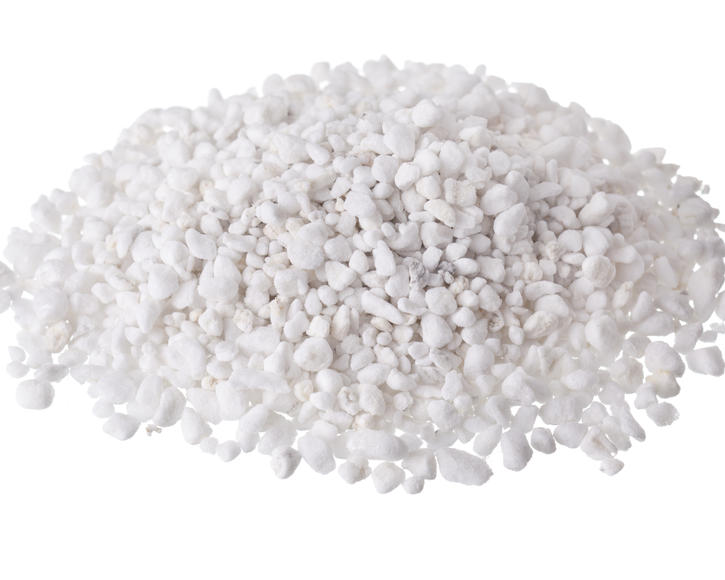Perlite
Perlite is a rock structure with a large surface area that holds a lot of water. It is therefore mixed into potting soils and other substrates. We explain what it’s all about.
The starting material for perlite is volcanic glass like obsidian. The volcanic glass is formed when lava with a low mass fraction of volatiles cools rapidly. What’s left is obsidian, a smooth, black volcanic glass. Weathering processes cause extremely thin cracks to form in this glass, water gets into these cracks, carrying and depositing minerals which form quartz, cristobalite, and feldspar over thousands of years. Finally, the original black obsidian is transformed into the porous loose rock perlite, which has a grayish color (depending on the mineral deposits) and an extremely large surface area thanks to numerous cracks and channels.
Due to the formation process, perlite is principally found in former volcanic regions. The main producers of perlite are Greece, Turkey, USA, and Japan.

To optimize the water retention characteristics of the raw material, perlite should be ‘popped’. This means rapidly heating it to around 1650 degrees. This procedure causes the water contained in the perlite to vaporize in seconds. As a result, the channels in the rock expand and the volume of the material increases by up to 20 per cent, while the weight – in relation to the volume – decreases. Due to the visual and physical similarities, amateur gardeners sometimes mistake popped perlite for polystyrene.
Used in this way, perlite is an ideal soil conditioner for gardens or pots, as it not only retains water, but also aerates the soil. When added to potting soil, the little beads ensure that there is no waterlogging. Perlite is also pH neutral and has an extremely low salt content. These properties make it ideal for use in gardens with very sandy soil, as this type of soil finds it very difficult to retain moisture. Perlite can also improve garden areas that only receive a little moisture or find it difficult to absorb moisture (loamy soils). The material’s storage capacity optimizes the water balance and provides better conditions for plants to thrive.
At large nurseries, perlite is even used on its own as a cultivation material. Nutrients are introduced through watering, retained in the perlite, and then released to the plants in the water.

Perlite usually comes in three different grades for different areas:
- 0–3 millimeter
- 0–6 millimeter
- 2–6 millimeter
The 0-6 millimeter grade is ideal for use as a soil conditioner in the garden. The 2–6 millimeter is recommended for improving potting soil or producing your own substrate, as the substrate tends to clog up with finer grades.
Even though many substrate manufacturers use perlite to improve their potting soils and it is now relatively well-known among amateur gardeners, it is still hard to come by in stores. Garden centers, DIY stores, recycling centers for building materials, and composting plants sometimes have it, so it might be worth asking there. However, as is often the case, the easiest option is to order it online. You’ll be able to find perlite in various pack sizes and grades. A 100 liter sack costs around 25 dollars.

